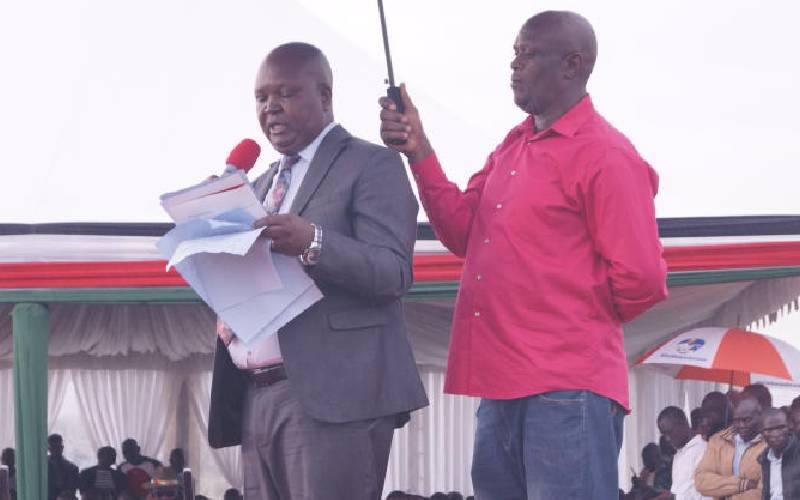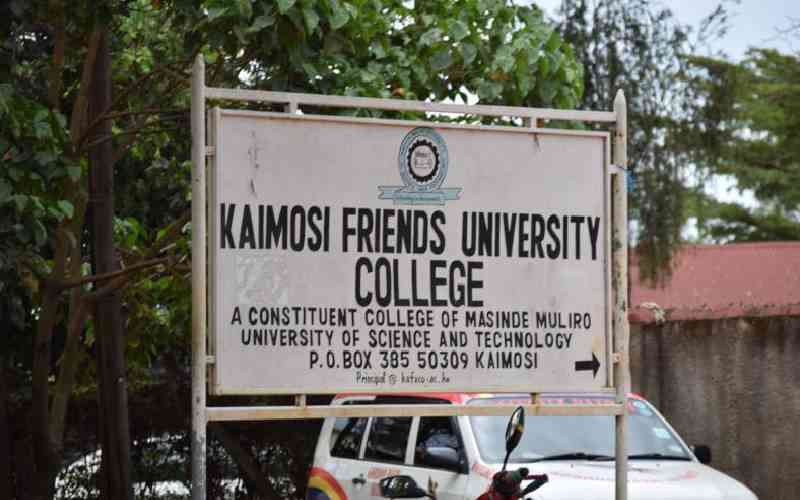As the August 8 General Election draws closer, Kenyans have been treated to all sorts of promises from across the political divide in a bid to win votes.
The pledges range from infrastructure development, enhanced maternal health care, cancer clinics, water, jobs for the youth, key government appointments, pensions for the elderly to free secondary education. Free secondary education stands out as one of the promises likely to be forgotten soon after the polls.
What is important though is that secondary education is being acknowledged as a key plank to escape from global poverty. According to the UNESCO’s Institute of Statistics (UIS), the world would cut poverty by 55 per cent if all adults completed secondary education.
Specifically, poverty numbers would be reduced by two-thirds in Sub-Saharan Africa if all adults attained secondary school education, according to a communiqué from the United Nations High Level Political Forum held in New York on July 10-19.
The meeting focused on global poverty eradication in pursuit of the United Nations Sustainable Development Goals. Subsequently, latching on those general standpoints, Kenyan politicians have been dangling the carrot of free secondary education in election manifestos and public rallies. But apart from scrapping of school fees, there have been no other explanations as to how secondary education will be improved for it to become a catalyst to loosen the shackles of poverty.
The current thinking that secondary education is critical to poverty reduction is based on UNESCO’s new analysis on education’s impact on poverty that shows that if all adults globally completed secondary education, 420 million people could be lifted out of poverty. Unfortunately, the imagined scenario does not seem to be working, as over 264 million children and youth are still out of school.
No progress
“Virtually there had been no progress in reducing out-of-school rates in recent years,” says UNESCO in a briefing paper, ‘Reducing Global Poverty through Universal Primary and Secondary Education’. Datasets from UIS indicates that 61 million, or 23 per cent of the total population in Sub-Saharan Africa, accounts for primary school children aged between six and 11, while 62 million, another 23 per cent, are adolescents of lower secondary school aged 12-14. “Hard hit is the cohort of older adolescents of upper secondary aged 15-17, as 141 million, or about 54 per cent, are out-of-school,” says the UIS paper.
The issue is serious in that the rates of out-of-school children, adolescents and youth have followed a similar trend in recent years. For instance, after a decline in the years after 2000, the primary out-of-school rate has barely changed, while that of the lower secondary has not changed since 2012. “The upper secondary out-of-school rate has also flattened in recent years,” says UIS.
Although that is the situation that Kenyan politicians hope to rectify by scrapping tuition fees in public secondary schooling, there is a rider that such education should be of high quality to be of some value to students.
Poverty cannot be eradicated through secondary or any other form of general education without addressing issues related to its access, inclusivity, equity, quality and relevance. The prevailing scenario is that good education provides people with knowledge and skills that increase their productivity and make them less vulnerable to risks.
“For instance, on average, one year of education is estimated to increase wage earnings by 10 per cent in Sub-Saharan Africa and likewise enables rural households to diversify their income-earning opportunities,” says Harry Patrinos, a manager at World Bank’s education sector and a specialist in basic education school management and financing.
But according to the UNESCO’s briefing paper, in most developing countries, including Kenya, even when students complete an education cycle, they do not get the expected skills because the quality of education is low. So, what type of free secondary education is being promised by the politicians to the electorate?
Going by the past records, it is too early to celebrate and when election time comes, voters should not base their choices on the promise of free secondary education. Since independence, there has never been a comprehensive plan by past governments to improve facilities in both primary and secondary schools.
The history of free primary education in Kenya as launched in 1974, 1979 and 2003 is replete with frustrations and disappointments. While the politicians went on basking over huge enrolments, often going up to over one million, the burden on basic learning facilities such as classrooms had never been well thought-out.
Stay informed. Subscribe to our newsletter
That had also been the case in early years after independence when demand for secondary education overwhelmed the Kenyatta regime that swiftly eased pressure by allowing communities to build their own secondary schools. During the first 10 years of independence, the mantra of the day was: “If you want a secondary school for your children, go ahead and build one.”
Subsequently, by 1973, the number of secondary schools had increased to 964 from 151 in 1963 and to 2,395 by 1986. However, while the resilience of local communities to provide secondary education to their children was and still is commendable, one cannot fail to notice the lukewarm spirit of the political class to expand quality primary and secondary education to benefit all Kenyans.
Commenting on status of such schools built on self-help basis, the late Prof George Eshiwani had this to say: “As expected, the examination performance of these schools is very poor. The provision of equipment is also very poor and physical structures are inadequate and of poor standard.” Nevertheless, today, there are no secondary schools in the category of Unaided Harambee Schools, as over the years they were integrated and allocated new categories by the government.
Although in recent years most of those institutions have been placed in categories of sub-county or county secondary schools, they still enjoy lower status in terms of physical facilities and the quality of students they admit in respect to performance in the Kenya Certificate of Primary Education (KCPE) examination.
Taking into account that this category of schools enrolls more than 70 per cent of students within the Kenya secondary education sector, Keith Lewin, a professor of International Education and Development at the University of Sussex, suggests, as a major policy shift, strengthening of the quality of education received by those who enter the sub-county and country secondary schools.
Political goodwill
But what is intriguing is whether there is sufficient political goodwill to improve learning facilities in the lower tier of public secondary schools, something that has eluded the country for the last half a century.
Interestingly, unlike so many other countries in Sub-Saharan Africa, many Kenyans have faith in the benefits that could be accrued from post-primary education but this has not been working for them as most students are usually enrolled in the low quality secondary schools that were initially established on self-help basis by the parents.
In recent years, enrolment in such low quality facilities has been increased by the initiatives of the Constituencies Development Fund that occasionally construct more classrooms in the existing schools or build secondary school wings in primary schools. Unfortunately, in most instances, learning facilities in primary schools are far much better than those of the attached secondary units.
In the face of it, those institutions are purposely built for the poor in the rural areas, as the Kenyan elite, irrespective of their political camps, take their children to much better schools.
No doubt this brings into mind that when the politicians are aggressively rolling out promises to the electorate, the litany is quite specific that, “we will provide free secondary education for your children,” but not “our children”.
In this regard, contrary to UNESCO’s objectives, Kenya’s basic education system lacks equity and inclusivity, while progress towards quality is at a snail’s pace, just in case it moves.
In essence, it appears Kenya’s secondary education, as in so many other countries in Sub-Saharan Africa, is not geared towards becoming a major bulwark against the massive unemployment.
 The Standard Group Plc is a
multi-media organization with investments in media platforms spanning newspaper
print operations, television, radio broadcasting, digital and online services. The
Standard Group is recognized as a leading multi-media house in Kenya with a key
influence in matters of national and international interest.
The Standard Group Plc is a
multi-media organization with investments in media platforms spanning newspaper
print operations, television, radio broadcasting, digital and online services. The
Standard Group is recognized as a leading multi-media house in Kenya with a key
influence in matters of national and international interest.
 The Standard Group Plc is a
multi-media organization with investments in media platforms spanning newspaper
print operations, television, radio broadcasting, digital and online services. The
Standard Group is recognized as a leading multi-media house in Kenya with a key
influence in matters of national and international interest.
The Standard Group Plc is a
multi-media organization with investments in media platforms spanning newspaper
print operations, television, radio broadcasting, digital and online services. The
Standard Group is recognized as a leading multi-media house in Kenya with a key
influence in matters of national and international interest.









